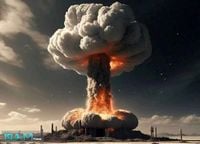On November 3, 2025, the world awoke to a chilling echo of the past as nuclear tensions surged on multiple fronts. Moscow, in a dramatic reversal of Cold War logic, is now wielding its nuclear arsenal to offset the West’s overwhelming conventional military superiority, while the United States—under former President Donald Trump’s directive—has shattered a decades-long moratorium by ordering the Pentagon to resume nuclear tests. These developments, coupled with China’s apparent preparations for its own underground tests, have reignited fears of a new arms race, thrusting the world into an era fraught with uncertainty and the specter of nuclear escalation.
According to Firstpost, Russia’s recent tests of the Poseidon nuclear-powered torpedo and the Burevestnik cruise missile are not just feats of military innovation; they are deliberate signals meant to rattle the sabres of doomsday escalation. The Poseidon, a submarine-launched, nuclear-powered underwater drone, measures a staggering 25 metres in length with a diameter of up to 2 metres. Russian sources claim it can travel at depths exceeding 1,000 metres—well beyond the reach of most anti-submarine weapons—and deliver a warhead with a yield of around 2 megatons. With nuclear propulsion granting it virtually unlimited range, the Poseidon could, at least in theory, traverse the Atlantic undetected and strike coastal cities in the United States or Britain. President Vladimir Putin hailed the weapon as unmatched, boasting, “No comparable system in the world can match its speed and depth, making it impossible to intercept.”
The Burevestnik cruise missile, tested in October 2025, adds another layer of unpredictability. As reported by Firstpost, it flew 14,000 kilometres in nearly 15 hours, operating at low altitudes and capable of remaining airborne for days thanks to its nuclear reactor. This allows it to take erratic flight paths that confound traditional air defense systems, further complicating the West’s ability to defend against such threats.
The strategic context, however, has shifted dramatically from the days of the Cold War. Where once NATO relied on nuclear weapons as a first-use deterrent to offset Soviet conventional dominance, Russia now finds itself in the opposite position—using nuclear threats to compensate for its own conventional military weakness. The United States and its NATO allies possess precision weaponry, advanced surveillance, and integrated air defenses that far outstrip Russia’s capabilities. This technological gap has forced Moscow to revise its nuclear doctrine, formally lowering the threshold for nuclear weapons use in November 2024. Now, Russia’s doctrine allows for nuclear response not only to existential threats but also to conventional attacks against Russian territory or Belarus that pose a “critical threat” to sovereignty or territorial integrity.
Meanwhile, the United States is taking its own dramatic steps. As detailed by The New York Times and corroborated by other outlets, Donald Trump has ordered the Pentagon to resume nuclear tests “on an equal footing with other nations,” ending a moratorium that had lasted since September 1992. Trump justified the move by stating, “America has more nuclear weapons than any other country, and during my first term, our nuclear arsenal was fully modernized and updated. Because of their massive destructive power, I hated to do it, but I had no other choice.” The last U.S. nuclear test, at the Nevada test site, marked the end of an era that began in 1945 and saw over a thousand detonations. Trump’s order comes on the heels of increased tensions with Russia over Ukraine and the deployment of U.S. nuclear submarines off the Russian coast.
The global response was swift and severe. China, as reported by The New York Times, called on the U.S. to adhere to the nuclear test ban and support global disarmament, warning that a resumption of tests would undermine strategic stability. Leonid Slutsky, Chairman of the International Affairs Committee of the Russian State Duma, warned, “The resumption of US nuclear tests, halted since 1992, could trigger a chain reaction and plunge global security into chaos.” Russian officials, including Sergei Shoigu and Kremlin spokesperson Dmitry Peskov, have made it clear that Moscow stands ready to resume its own nuclear tests if the U.S. abandons the moratorium. Peskov stated, “If any power withdraws from the moratorium on nuclear weapons testing, Russia will be forced to do the same.”
There are mounting concerns among experts that the U.S. may struggle to revive its testing program. Ernest Moniz, former U.S. Secretary of Energy, estimated that even a demonstrative nuclear explosion would require a year of preparation. Corey Hinderstein, a former senior official at the National Nuclear Security Administration, noted that drilling a new vertical shaft alone could cost around $100 million. Paul Dickman, a seasoned nuclear policy official, warned of a “brain drain,” stating, “Effective test managers are not bureaucrats or people behind PowerPoints. They are people who have real, practical experience.”
Perhaps most alarming is the potential for a new nuclear arms race. Ankit Panda, senior fellow at the Carnegie Endowment for International Peace, argued that a U.S. test would “effectively give China and Russia a green light to restart full-yield nuclear tests, something neither has done for years.” The Stockholm International Peace Research Institute estimates the current nuclear warhead counts as follows: the U.S. with 5,177, Russia with 5,459, and China projected to reach 1,500 by 2035. The sheer scale of destructive power is enough to end civilization as we know it—a fact not lost on any of the world’s major powers.
Russia’s nuclear threats, however, are not just military maneuvers; they are psychological warfare aimed squarely at Western publics. As Firstpost observes, Moscow seeks to convince Americans, Britons, and Europeans that supporting Ukraine or maintaining NATO commitments is simply too risky—that their own cities and children could be sacrificed for distant lands. This strategy exploits a fundamental truth about liberal democracies: the lives of their citizens are valued above abstract principles of international order.
Yet the risk of miscalculation has never been higher. The ongoing Ukraine conflict has structurally embedded the risk of nuclear escalation, especially as NATO expands and continues to support Kyiv militarily. Russia views this as an existential threat, and the absence of formal arms control agreements or buffer zones only heightens the danger. As conventional options narrow for Moscow, its nuclear options broaden—a logic chillingly reflected in its revised doctrine.
The United States, for its part, is not limiting its nuclear ambitions to its own arsenal. By granting approvals to close allies like Australia and South Korea to develop nuclear-powered submarines, Washington is effectively extending the nuclear rivalry into new regions and alliances. This move, intended as a regional deterrence against China and Russia, signals a strategic shift in U.S. global policy—one that could further destabilize strategic balances in East Asia and the Pacific.
Should this trend of nuclear competition persist, the world may once again find itself on the brink of a new era of mutual distrust and weapons development. The legitimacy of international arms control institutions and non-proliferation treaties is at risk, and as new actors seek to join the nuclear club, the global balance will grow ever more fragile. The shadow of uncertainty and insecurity looms larger than it has in decades.
Today’s nuclear brinkmanship is not just a contest of missiles and warheads—it is a test of the world’s collective resolve to avoid catastrophe. With each new deployment, each test, and each rhetorical escalation, the margin for error narrows. The stakes, quite simply, could not be higher.




